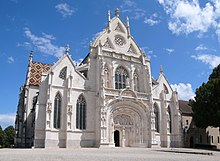 Façade of the church, Royal Monastery of Brou | |
 | |
| 46°11′51″N 5°14′11″E / 46.1976°N 5.2363°E | |
| Location | Bourg-en-Bresse, Ain, Auvergne-Rhône-Alpes, France |
|---|---|
| Width | 30m |
| Height | 72m |
| Beginning date | 1506 |
| Completion date | 1532 |
| Website | http://www.monastere-de-brou.fr/ |
The Royal Monastery of Brou is a religious complex located at Bourg-en-Bresse in the Ain département, central France. Made out of monastic buildings in addition to a church, they were built at the beginning of the 16th century by Margaret of Austria,[1] daughter of the Holy Roman Emperor Maximilian I and Governor of the Habsburg Netherlands. The complex was designed as a dynastic burial place in the tradition of the Burgundian Champmol and Cîteaux Abbey, and the French Saint-Denis. The church is known as the Église Saint-Nicolas-de-Tolentin de Brou in French.
The church was built between 1506 and 1532 in a lavishly elaborate Flamboyant Gothic style, with some classicizing Renaissance aspects. The tall roof is covered in coloured, glazed tiles. Margaret, her second husband Philibert II, Duke of Savoy, and his mother, Margaret of Bourbon, are all buried in tombs by Conrad Meit within the church, which have avoided the destruction that most royal tombs in France have suffered.
The monastery is the property of the town of Bourg-in-Bresse, which installed the municipal art collection in the buildings in 1922. The museum presents religious statues of the 13th to 17th centuries on the ground floor, and a collection of paintings of the 16th to the 20th centuries on the upper floor.
The church and monastery have been classed as a monument historique since 1862. The buildings are in the care of the French state, and are managed by the Centre des monuments nationaux.
- ^ Gelfand, Laura D. (2003). "Margaret of Austria and the Encoding of Power in Patronage: The Funerary Foundation at Brou." In Widowhood and Visual Culture in Early Modern Europe, edited by Allison Levy. Aldershot: Ashgate. pp. 145–165.